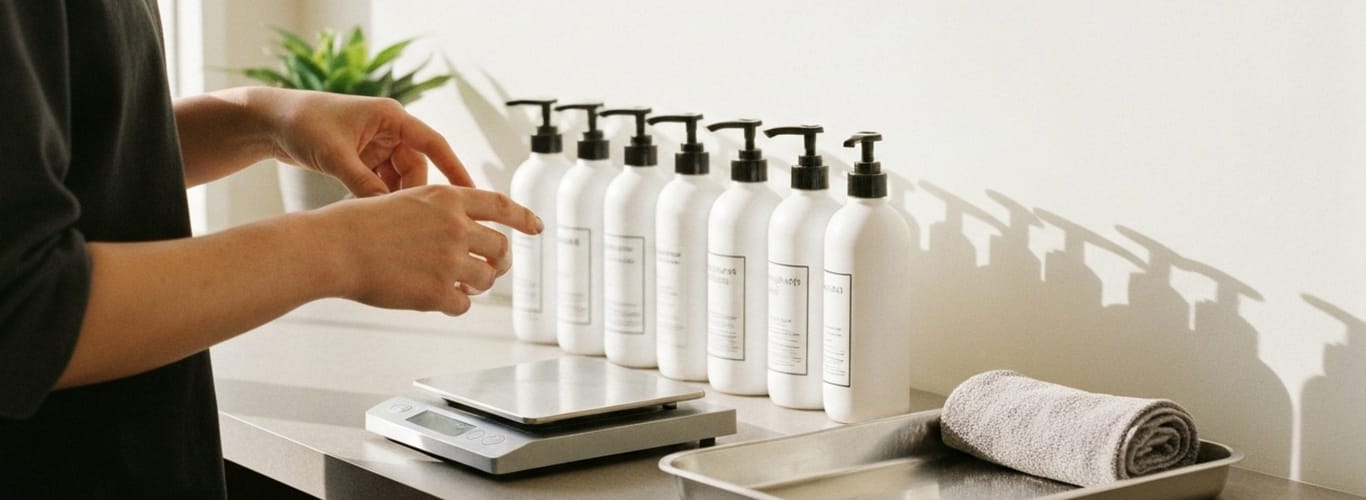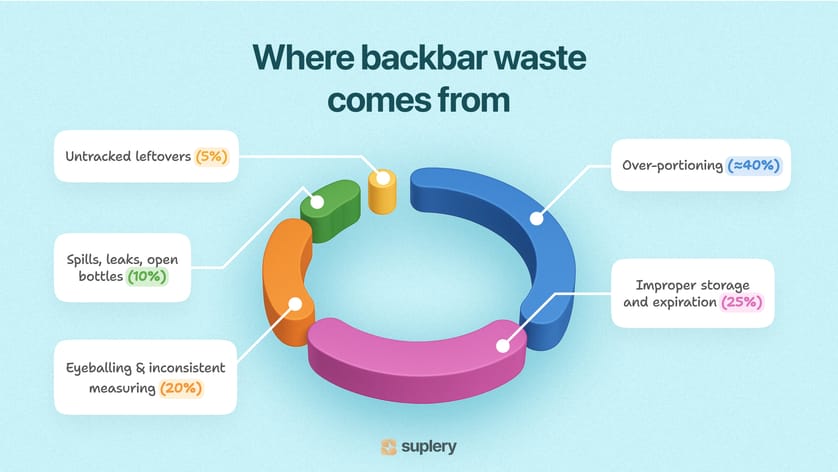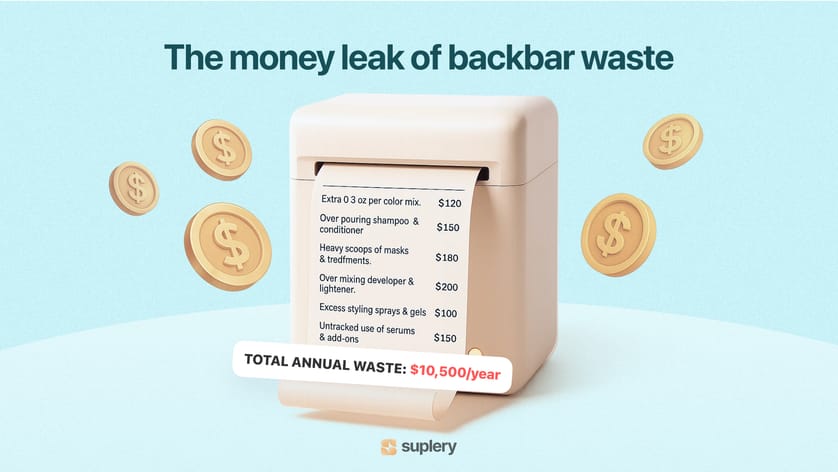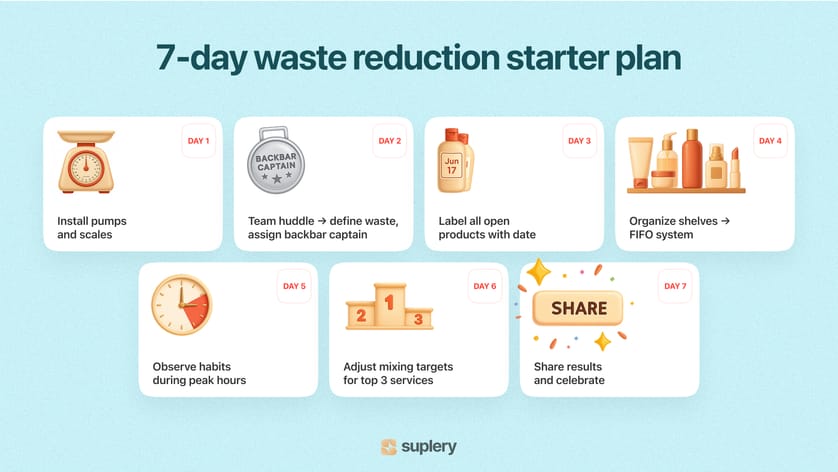Beauty salon backbar waste: how to reduce and save money
Let’s be honest: most studios don’t lose profit in big, dramatic ways. They lose it drip by drip — a few extra pumps here, an over-generous bowl there, half-open bottles oxidizing on the backbar. Industry estimates suggest that up to 30–40% of product gets lost unnecessarily when beauty salon backbar waste goes unchecked. That’s not just cost down the drain — it’s also chemicals into the water system, additional product loss, and missed opportunities to position your brand as truly sustainable in the competitive professional beauty sector.
This article is a practical guide to salon waste management: what creates waste, why reducing it is worth fixing now, and how to tighten things up without turning your team into robots. We’re not going deep into a full inventory management system here — if you’re looking for a breakdown of the best tools, check our guide Best salon inventory management software (2025): pricing, pros & cons. Today is about waste and how to reduce inventory waste, cut costs, and save money fast, smart, and permanently.
Main sources of backbar waste
Over-portioning and “just in case” mixing
The #1 culprit. It feels safer to mix a little extra color or pour a heavier dollop of mask “just in case.” Multiply that habit across 10 stylists and 120 services a month, and you’ve built a very expensive security blanket that contributes to general salon waste.
Quick math reality check: if a color service should use about 2 oz (≈50 g) but you regularly overmix by 0.3 oz (≈10 g), and you do 120 color services a month, that’s 42 oz (≈1,200 g) — roughly 12 full tubes — you never use. At $10 per tube, that’s $120/month or $1,440/year on one category alone — before we even talk developer, lighteners, or treatments.
Improper storage and product degradation
Heat, sunlight, and air exposure break formulas down. Caps left loose, pumps that don’t close fully, bottles living on hot shelves — it all speeds up oxidation and texture changes. You end up tossing products not because they were “bad,” but because they were badly stored, turning usable stock into unnecessary excess.
Eyeballing instead of measuring
Stylists are artists — agreed. But a backbar is a lab, whether we like it or not. Eyeballing works until it doesn’t: a lavish pour here, a slightly off ratio there. Consistency needs measurement, not vibes — and not uncontrolled product waste.
Spills, over-pouring, and open bottles
Leaky pumps, slippery hands, cluttered trays, and rushed clean-ups. Open bottles invite evaporation, contamination, and loss. Spills don’t just make floors slick; they make margins thin and create unnecessary beauty waste.
Untracked leftovers
What happens to the color left in the bowl? Or the last bit of treatment at the bottom of a jar? Without a plan, it becomes “no one’s product” — and no one’s responsibility. That’s how backbar waste quietly turns into a normal habit, and why proper waste management matters.
Why reducing waste is critical
Higher profit without raising prices
Waste reduction is the cleanest margin play you have. You’re not selling more services or pushing higher prices — you’re simply using what you already buy, correctly. Lower write-offs = better gross margin on every service. And yes, salon owners who cut waste also save money every single month.
Real eco practices, not greenwashing
Guests see through performative eco-talk. Cutting chemical waste at the source (your backbar) is tangible, measurable, and marketable. Less product into the sink, fewer containers in the trash, smarter use of what you already own. Every time you focus on reducing waste, you also lower environmental impact and conserve natural resources.
Better, more consistent results
Precise ratios = predictable outcomes = fewer redos and refunds. Waste reduction isn’t just cost control; it’s also quality control that protects the customer experience and your workplace’s reputation.
Stronger brand position
Sustainable isn’t just a badge; it’s a behavior. When you can say “we cut our backbar waste by 20% in 90 days,” that’s a story guests and staff are proud to stand behind — and one that positions you as a modern green salon.
Reducing backbar waste is just one piece of the puzzle — for a full playbook on how to turn salon inventory control into profit, see our article Salon inventory management: a guide to a successful business.
Practical ways to reduce backbar waste
This is where you shift from “we should” to “we do.” None of these require a giant system overhaul. Start with two or three this week, and stack from there.
Standardize measuring — make it impossible to guess
- Scales for color (accuracy to 0.004 oz ≈0.1 g), ounce markings on bowls and bottles, and pre-set pumps (e.g., about 0.07 fl oz per press for shampoo, 0.03 fl oz for serums).
- Post ratio cheat sheets at every station: “Color X = 1:1.5, Lightener Y = 1:2.”
- Move from “mix until it looks right” to “mix until it weighs right.” Art stays; guesswork goes.
Portion control for wet bar items
- Fit shampoos, conditioners, and masks with pump tops. Teach the actual dose per hair length:
- Short: 1–2 pumps
- Medium: 2–3 pumps
- Long/thick: 3–4 pumps
- Add a small dose chart sticker on the mirror frame or trolley. Visibility changes behavior.
Tiny math that adds up: just 0.2 fl oz extra per wash × 20 washes/day × 25 days = about 85 fl oz (0.7 gal) wasted each month. Each product line ends up costing you an extra $50 a month in waste.
Proper storage and FIFO without the drama
- FIFO (first in, first out): newest stock to the back, oldest to the front.
- Label every item when opened: date + Initials. “If it’s open, it’s dated.”
- Keep backbar away from heat/bright light: cap everything tightly between uses.
- Consolidate duplicates so half-empty containers don’t breed on shelves.
A simple leftovers policy (so product doesn’t become orphaned)
- Color: leftover color can’t be stored or reused on customers safely. Instead, log when and why leftovers happen (e.g., guest added highlights, overestimation). Use these notes to refine future mixing guidelines.
- Treatments: set aside a clearly labeled “training use” tray for in-house demos and staff services within 24–48 hours if product integrity allows. After that, discard.
- Small jars: use spatulas instead of fingers to prevent spoilage and extend shelf life.
Micro-audits that take 10 minutes, not a full day
- Weekly quick scan: Which items are frequently left open? Which pumps leak? Which station shows the most residue?
- Monthly mini-count: Just your top 20 backbar SKUs (color families, developer sizes, core masks). Track “expected vs. actual” use by service volume.
- Quarterly clean-down: Trash expired items, consolidate duplicates, replace faulty pumps, and re-post ratio charts.
Set waste triggers and thresholds
- Agree on what counts as waste: leftover in bowl? Drips on tray? Expired jar?
- Set a threshold (e.g., “>10% leftover in bowl after color mix is a trigger”). If you hit it three times, you adjust the formula or process.
Signage that actually works (copy-paste this)
- “Mix what you’ll use. Use what you mix.”
- “Cap it, date it, save it — or toss it.”
- “One more pump isn’t better. It’s just more.”
If you want real-world proof that small changes cut thousands in waste, read how other owners did it in From stock chaos to profit: 6 salon inventory case studies.
The 7-day starter plan (fast, visible wins)
Day 1: Fit pumps, place scales, print dose charts. Day 2: Team huddle: define waste, agree on leftovers policy, assign a “backbar captain.” Day 3: Label everything currently open with date/initials. Day 4: Tidy shelves into FIFO flow; remove clutter and duplicates. Day 5: Observe two peak hours; note over-pour habits and quick fixes. Day 6: Adjust mixing targets for top three services with the most leftovers. Day 7: Share early wins: “We cut color leftovers by 12% this week.” Celebrate. Repeat.
Engaging the team
You could post rules everywhere — or you could build pride. Waste reduction sticks when the team sees it as a craft standard, not a punishment. Strong waste management practices are about teamwork, not control.
Coach, don’t police
Invite stylists into the why: precise ratios protect results, reviews, and rebookings. If a stylist consistently has leftovers, adjust their target mix together. Make them the hero of their own improvement.
Give ownership with small, clear roles
- Backbar captain (rotates weekly): checks caps, pumps, and labels at end of day.
- Shelf lead: keeps FIFO layout tight and eliminates duplicates.
- Education buddy: refreshes ratio cheat sheets and dose stickers.
Make it visible and fun
- Before/after photos of the backbar. Nothing motivates like a clean, intentional workspace.
- Waste scoreboard (simple whiteboard): “Color leftovers this week: 9 oz → goal: 7 oz.”
- Zero-waste challenges: “No leftover bowls for 7 days” wins coffee for the team.
Celebrate the savings — and where they go
Turn reduced spending into something the team can feel: part funds new tools, advanced classes, or a team dinner. When stylists see cost reduction turning into benefits, they’ll protect it fiercely.
Optional advanced step: incorporate product usage costs into bonus or salary structures. For example, reward stylists who consistently keep leftovers below agreed thresholds — turning good habits into direct financial recognition.
Environmental and marketing benefits
Waste reduction is a backstage habit with front-of-house power. Your guests don’t watch you measure developer to the gram, but they do notice how you talk about eco practices.
Credibility your guests can trust
Saying “we care about the planet” is cute. Saying “we reduced our studio waste by 20% in three months by standardizing doses and closing bottles between steps” is credible. One is a caption; the other is a claim.
How to bake it into your brand (without sounding preachy)
- Add a planet-first mindset note to your website’s service page:“We’re a low-waste studio. We mix to the gram, label every open product, and keep chemicals out of sinks and landfills whenever possible.”
- Post monthly wins on Instagram:“Backbar update: 1.8 L less shampoo wasted in August = 90 extra washes saved. Tiny habits, big impact.”
- Train front-desk to mention it casually when guests compliment results:“Consistency is our thing — we measure everything. It’s better for your hair and for the planet.”
Eco practices customers actually feel
- Refill retail where your brand partner allows (bring-back bottles).
- Remind guests that a salon doesn’t only cut chemical waste — it also reduces packaging waste, sorts paper waste into a recycling bin, and ensures hazardous waste like used foils or color tubes is properly disposed.
- Use recycle partners for plastics, foils, and hazardous materials where available, and talk about it briefly (no guilt trips).
By addressing not only backbar loss but also general waste streams like hair clippings, empty bottles, and packaging, you show your workplace cares about both profit margins and the environmental impact of the salon business.
Quick tools & templates you can print
Make waste reduction simple and visible.
We’ve turned the most useful reminders into ready-to-print templates — mirror stickers, station signs, open-date labels, and leftovers notes. Print them out, stick them where your team works, and watch how small habits start saving you big money.
Download your smart backbar toolkit
Ready-to-print templates to track product opening, measure doses, log leftovers, and cut backbar waste. Download now and run your inventory smarter.
Oh no! We couldn’t subscribe you ☹️
Done! We've sent a link to your Email 📨
Your next move: cut the waste
Every drop counts. When backbar habits go unchecked, you’re not just wasting stock — you’re wasting margin, consistency, and trust. The shift is simple: measure instead of guessing, label instead of forgetting, and teach your team that waste isn’t “extra,” it’s expensive.
- Cutting waste is profit. You’re not charging more — you’re keeping what you already earn.
- Cutting waste is quality. Consistent portions = consistent results guests rave about.
- Cutting waste is brand power. Real eco practices make your workplace stand out.
And if your goal is to go beyond waste reduction and really slash expenses, check out our guide on Cut inventory costs in salon: save on salon inventory & optimize stock.
Start small, but start now. Fit pumps, print cheat sheets, and make waste visible. From there, build habits your whole team can own. The leaks will stop, the savings will stack, and your business will have a story every guest wants to be part of.
 The latest articles and industry insights delivered to your inbox
The latest articles and industry insights delivered to your inbox
Subscribe to receive a monthly digest of our most valuable resources like blog posts, whitepapers, and guides.
Oh no! We couldn’t subscribe you ☹️
Done! You've subscribed 💛
Unsubscribe anytime. Your data is stored for business-to-business communication purposes. See our Privacy policy.
Frequently asked questions
What types of waste does the professional beauty sector generate beyond backbar loss?
The beauty industry generates not only backbar product waste but also general salon waste like hair clippings, empty bottles, cotton buds, used foils, and packaging. Some of this is harmless, while other materials are considered hazardous waste or even clinical waste that requires proper disposal under local regulations.
How should hazardous waste and hazardous materials be handled in a salon?
Items like color tubes, chemicals, and used foils count as hazardous materials. They must be collected separately, properly disposed of, and sent to recycling partners or facilities specialized in hazardous waste management. Correct handling keeps salons compliant and protects both staff health and the environment.
Can any salon waste be reused or recycled?
Yes. While leftover color can’t be reused, some materials can be recycled — like foils, plastic bottles, and paper packaging. Certain studios also experiment with ways to reuse materials, such as repurposing hair clippings for compost or community projects. Partnering with recycling programs makes waste management more efficient and contributes to a green salon reputation.
What about water and energy waste in studios?
Water consumption in the salon business is significant. Installing low-flow showerheads at shampoo stations can cut usage without affecting service quality. Turning off unused tools and switching to LEDs reduces energy bills. These small steps reduce environmental impact and support overall waste management practices.
Why is proper disposal essential for salons?
Incorrect handling of salon waste doesn’t just hurt the planet — it can also lead to fines, reputational damage, or even legal issues. Ensuring proper disposal of chemicals and excess waste shows customers you take responsibility seriously. It also positions your business as a leader in sustainable practices while helping to increase profits by avoiding unnecessary costs.
How do landfills connect to salon waste?
Every unused product, empty bottle, or cotton bud that isn’t recycled usually ends up in a landfill. By reducing general waste, recycling more, and ensuring products are correctly disposed of, salons cut their contribution to landfill volume and demonstrate authentic care for the planet.
Last updated on Sep 29, 2025
This is a brand-new, practical guide on how to reduce beauty salon backbar waste and save money.
Please share this post
Table of Contents
Main sources of backbar wasteWhy reducing waste is criticalPractical ways to reduce backbar wasteEngaging the teamEnvironmental and marketing benefitsYour next move: cut the wasteFrequently asked questionsBest salon inventory management software (2025): pricing, pros & cons
Discover the ultimate salon inventory software guide for 2025. Compare top platforms, reduce product waste, boost profits, and learn how leading salons effectively choose and implement inventory solutions.
Inventory management in beauty business
10 min
From stock chaos to profit: 6 salon inventory case studies
See how top salons streamlined inventory, slashed costs, and grew profits. Steal these proven strategies and turn your stockroom into a secret profit weapon.
Inventory management in beauty business
8 min
How much does a salon owner make | Average salon owner salary
Want to know how much a beauty business owner can make? Our comprehensive guide has got you covered. Explore the factors that affect salaries, discover industry trends, and get valuable tips for success in the beauty business.
Beauty salon operations & Team management
7 min
Unlock FREE bonus material!
Get your hands on "Smart backbar toolkit: printable templates for salon control". Subscribe to our newsletter and receive a link to download it straight to your inbox.
Oh no! We couldn’t subscribe you ☹️
Done! We've sent a link to your Email 📨
Trusted by the best in the beauty industry.
Transform your beauty business with Suplery!
Already enjoying our expert tips? Take the next step and join Suplery to revolutionize your business operations.
Huge range of professional products
One-click checkout after first order
Automated predictive orders
Seamless inventory management
From words to action
Start working with Suplery and explore all the tools and services you need to expand your business
Get started with Suplery24/7 Support
Secure payments
Designed by industry’s experts









